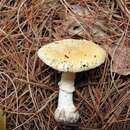Comprehensive Description
(
anglais
)
fourni par North American Flora
Venenarius crenulatus (Peck) Murrill, Mycologia 5: 77. 1913
Amanita crenulata Peck, Bull. Torrey Club 27: 15. 1900.
Pileus thin, broadly ovoid, becoming convex or nearly plane, 2.5-5 cm. broad; surface whitish or grayish, sometimes tinged with yellow, decorated with a few thin, whitish, floccose warts, or with whitish, floccose volval patches, somewhat striate on the margin; context white, agreeable to the taste; lamellae white, crowded, reaching the stipe and sometimes forming decurrent lines, edges floccose-crenulate ; spores globose, smooth, hyaline, usually uninucleate, 7.5-10 ju; stipe equal, bulbous, floccose-mealy above, white, stuffed or hollow, 2.5-5 cm. long, 6-8 mm. thick; annulus slight, evanescent; volva whitish, very thin and fragile, evanescent.
Type locality: Eastern Massachusetts. Habitat: Low ground under trees. Distribution : Massachusetts.
- citation bibliographique
- William Alphonso Murrill. 1914. (AGARICALES); AGARICACEAE (pars). North American flora. vol 10(1). New York Botanical Garden, New York, NY
Amanita crenulata: Brief Summary
(
anglais
)
fourni par wikipedia EN
Amanita crenulata, also known as the poison champagne amanita, is a species of fungus that is very common in the Northeast United States.
- licence
- cc-by-sa-3.0
- droit d’auteur
- Wikipedia authors and editors

